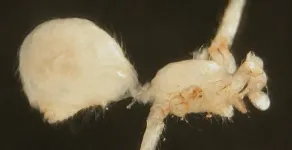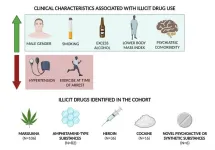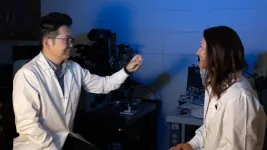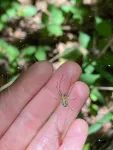(Press-News.org) Cognitive and computer scientists at the University of Toronto, Universitat Pompeu Fabra and the Catalan Institution for Research and Advanced Studies have found child language development and the historical evolution of the world’s languages share a common cognitive foundation—a core knowledge base where patterns of children’s language innovation can predict patterns of language evolution, and vice versa.
Published today in Science, the paper is a first-of-its-kind step toward a unified theory of the lexicon and the mind examined across timescales. The result may also help predict how a word’s meaning may change in the future—across different languages, in language learners and in machine learning.
For the study, the team focused on a common form of human lexical creativity, or word coinage, known as word meaning extension—where people use known words to express something new instead of creating new words. For example, the word “mouse” in the historical evolution of English extends from its rodent meaning to refer to a portable computer device. In language development, children as young as two years old can use the word “ball” to refer to “balloon,” presumably because they haven’t yet acquired the right word to describe “balloon,” so they overextend the known word “ball” to express that new object.
“We investigated processes of word meaning extension across populations and within individuals, and at two very different timescales—in language change and evolution, which take over hundreds and thousands of years, and in child language development during the first few months and years of life,” says last author Yang Xu, Associate Professor, Department of Computer Science, Cognitive Science Program, University of Toronto. “We found that these diverse processes are fundamentally the same, and that the creation of new word meanings relies on a shared foundation of knowledge grounded in human experience.”
First author Thomas Brochhagen, Assistant Professor, Department of Translation and Language Sciences, Universitat Pompeu Fabra says, “This possible relationship between individual learning and the evolution of languages in terms of how meaning is organized had not been demonstrated thus far, and our study does so on a large scale and in a generalized way.”
For the study, the researchers built a computational model that takes pairs of concepts as input, such as “ball” versus “balloon” and “door” versus “key” and makes a prediction about how likely these concepts can be co-named under the same word.
To identify similarities between concepts, the model draws on four primary knowledge types grounded in human experience: visual, associative, taxonomic (how terms are organized in a hierarchy, like referring to an apple as a fruit), and affective (how pleasant and intense a term is, like “sunny”).
The pair of concepts like “ball” and “balloon” would score high due to their similar visual features, whereas “door” and “key” would score high because they are thematically related or often occur together in daily scenarios. “Water” and “pencil” would have little similarity measured in any of the four knowledge types, so that pair would receive a low score. As a result, the model would predict they are unlikely to extend to each other.
The team found that the four knowledge types contributed to word meaning extension which indicates that word meaning extension relies on multifaceted and grounded knowledge based on people’s perceptual, affective, and common-sense knowledge.
The researchers then performed a cross-predictive analysis using a model built exclusively from children’s word meaning extension data to predict successfully word meaning extension patterns from both language evolution and language change, and in the reverse.
The researchers also checked the robustness of these predictive models in languages other than English, verifying that the creation of new word meanings follows similar patterns in 1,400 different languages, including Spanish, Catalan, Basque, Galician, German, French, Portuguese, Dutch, Danish, Norwegian, Swahili, Arabic, Mandarin Chinese, Hindi and Korean.
Existing research on child overextension is typically discussed in the context of developmental psychology whereas word meaning extension in history is typically discussed in historical and computational linguistics.
“By building this connection between the two fields, we find a core knowledge engine that supports lexical creativity in word meaning extension, which is fundamentally important to human cognition and linguistic communication of emerging meanings,” says Xu.
These computational models may also help facilitate and understand second language acquisition by interpreting errors that learners made in English and other languages, which could resemble how children and adults extend word meaning in their mother tongue.
Future research will further explore the origins and cognitive mechanisms of human lexical creativity, and the possibility of predicting new or emerging meaning in both human language development and machine learning systems.
“Developing a unified theory of the mind across timescales is a challenging undertaking—we don’t have access to human minds dating back hundreds or thousands of years,” says Xu. “Our study offers an alternative way for exploring this unification through the lexicon—a creative product of the human mind and the system of word-meaning mappings, for which we have data available to us.”
-30-
END
People often debate whether social media creates "echo chambers" by showing users content that matches their politics and in turn increases polarization. A new study published today in the journal Nature reports that reducing Facebook users' exposure to content from politically "like-minded" sources had no measurable effect on their political beliefs or attitudes during the 2020 U.S. presidential election.
The findings are part of a broader research project examining the role of ...
Australia’s rich and diverse fauna never fails to surprise us, as a new spider species has been documented from the continent.
The novel species, a blind daddy long-legs, was found in boreholes in the arid Pilbara of Western Australia. It is the first cave-adapted daddy long-legs spider reported from the continent, with other blind species of its genus so far only found in Thailand, Laos, and Vietnam.
“It represents a subfamily that was previously thought to be restricted to the tropical north and east of the continent,” says Bernhard Huber, one of the authors of a recent study published ...
27 July 2023
Geological Society of America
Release No. 23-28
Contact: Justin Samuel
+1-303-357-1026
jsamuel@geosociety.org
Boulder, Colo., USA: GSA is pleased to welcome three exceptional new Fellows who will join us in our mission to advance geoscience knowledge and discovery through excellent writing, research, and advocacy.
GSA’s 2023–2024 Science Communication Fellow is Arianna Soldati.
Soldati is an assistant professor of volcanology at North Carolina State University. Her lab group works on a variety of topics, ranging from effusive eruptions to critical minerals. She received her Ph.D. in geological sciences from the University of ...
New Haven, Conn. — In a promising form of immunotherapy known as CAR T-cell (chimeric antigen receptor) therapy, the patient’s T cells are engineered to better recognize and attack antigens on the surface of cancer cells. In treatments currently approved for use in battling lymphoma and leukemia, however, the therapy has a drawback: Amidst the cancer-killing frenzy, many engineered T cells become tainted with the remnants of cancer antigens, which causes them to turn on other T cells. This eventually depletes the body of cancer-fighting cells ...
Digital Science, a technology company serving stakeholders across the research ecosystem, is pleased to announce that the Research Corporation for Science Advancement (RCSA) has chosen Symplectic Grant Tracker from Digital Science’s suite of flagship products to advance its aims of providing catalytic funding for innovative scientific research and the development of academic scientists.
RCSA joins the 50+ foundations, charities and funders worldwide who manage their end-to-end grant lifecycle using Symplectic Grant Tracker. Designed from the outset to meet research funding needs, Grant Tracker includes features to assist applicants, reviewers, committees and ...
PHILADELPHIA (July 27, 2023) – Two decades ago, the Practice Environment Scale of the Nursing Work Index was published to measure the nursing practice environment. Although the instrument's use has resulted in advances in science and quality improvement efforts, its potential may be limited by the availability and quality of translations into different languages.
Researchers from the University of Pennsylvania School of Nursing (Penn Nursing) investigated published translations of the instrument and have identified ...
Philadelphia, July 27, 2023 – Approximately one-third of young adults in Victoria, Australia, who experienced sudden cardiac deaths (SCDs) outside of a hospital setting from April 2019 to April 2021 used illegal drugs prior to their fatal events, reports a new study in Heart Rhythm, the official journal of the Heart Rhythm Society, the Cardiac Electrophysiology Society, and the Pediatric & Congenital Electrophysiology Society, published by Elsevier. The analysis of data on substance abuse, revealed through positive toxicology reports and patient histories and recorded in one of the world’s largest and most comprehensive SCD registries, ...
In a new study funded by a $3 million grant from the National Institutes of Health (NIH), University of Missouri researcher Kiho Lee, an associate professor in the College of Agriculture, Food and Natural Resources, will use gene editing to investigate the building blocks of disease. His ultimate goal — to discover clinically significant explanations for human diseases like Alzheimer’s, cancer and infertility, while working on solutions to global food insecurity.
Common diseases, such as Alzheimer’s, are widespread in humans, plaguing an estimated 11% or 6.7 million Americans over age 65, according to The ...
Spiders are often maligned for being creepy critters, but they are some of the most environmentally friendly pest regulators. Because they actively feed on flies, moths, mosquitoes and roaches, spiders eliminate parasites and many other vectors of disease—protecting both humans and plants from harm.
A new University of Maryland-led study published online in the journal Ecology found one simple way to take advantage of this natural ecosystem service: give tree-dwelling spiders a more diverse habitat.
“We found that there’s ...
NDIANAPOLIS—Researchers from Indiana University School of Medicine have diagnosed a Sumatran Orangutan at the Indianapolis Zoo with a rare genetic disease called Alkaptonuria. This is the first time the disease has been confirmed molecularly in a primate other than a human.
The six-year-old orangutan, named Mila, was born at the Indianapolis Zoo in 2016. Mila had a history of dark urine that turned brown upon standing since birth, but has never shown other symptoms. Researchers from the IU School of Medicine Department of Medical ...







